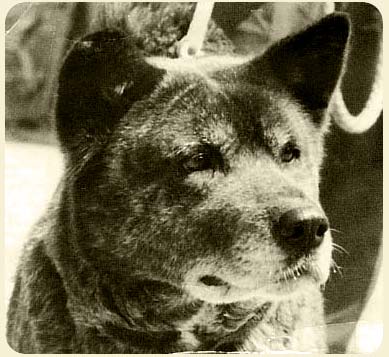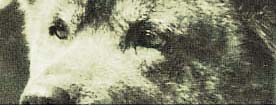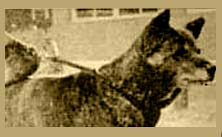 Save this page (76.6 kb)
Save this page (76.6 kb)
Akita Dogs Dear to Our Hearts: Daiunme-Go
By Shinichi Ishiguro DVM
 It was perhaps in the Spring of the 37th year of Showa (1962), when my friend of dogs, Kiyoshi Komatsu, dropped in unexpectedly as is usually the case with him. "There is an interesting bitch at Tame-san Ishibashi's place in Yuzawa. The sire is Daiun-go out of Tamagumo and Makome (Goromaru and Oshume). The dam is Kiyome-go out of Tamagumo and Kiyohime (Goromaru and Chinpei). She looks great and is often referred to as the Tamagumo-type female," said Komatsu. Tame-san refers to Mr. Tamejiro Ishibashi, one of the foremost pupils of Mr. Heiemon Kiyono of the City of Yuzawa in Akita. Prior to the war, Mr. Kiyono was the dean of the Akita dog world when he directed the development of the Akita Nikkei line with Nippo. Although I was aware of the very close friendship between Tame-san and Komatsu, I did not for the moment believe that a person such as Ishibashi would release to Komatsu such a dog from an outstanding bloodline at the spur of the moment. Komatsu continued his story. "She is almost three years old, but Tame-san seems to be ready to release her to someone else because of many miscarriages and stillbirths. Any hopes of her producing offspring by some miracle?" There are examples of conception occurring at the age of five years after many failures. However, failure to conceive is a separate problem. Stillbirths and miscarriages may mean that some factor(s) could be correctable after conception. "I'll do my best to see what I can do about it. Why don't you bring her over?" said I. Komastsu then headed toward Yuzawa.
It was perhaps in the Spring of the 37th year of Showa (1962), when my friend of dogs, Kiyoshi Komatsu, dropped in unexpectedly as is usually the case with him. "There is an interesting bitch at Tame-san Ishibashi's place in Yuzawa. The sire is Daiun-go out of Tamagumo and Makome (Goromaru and Oshume). The dam is Kiyome-go out of Tamagumo and Kiyohime (Goromaru and Chinpei). She looks great and is often referred to as the Tamagumo-type female," said Komatsu. Tame-san refers to Mr. Tamejiro Ishibashi, one of the foremost pupils of Mr. Heiemon Kiyono of the City of Yuzawa in Akita. Prior to the war, Mr. Kiyono was the dean of the Akita dog world when he directed the development of the Akita Nikkei line with Nippo. Although I was aware of the very close friendship between Tame-san and Komatsu, I did not for the moment believe that a person such as Ishibashi would release to Komatsu such a dog from an outstanding bloodline at the spur of the moment. Komatsu continued his story. "She is almost three years old, but Tame-san seems to be ready to release her to someone else because of many miscarriages and stillbirths. Any hopes of her producing offspring by some miracle?" There are examples of conception occurring at the age of five years after many failures. However, failure to conceive is a separate problem. Stillbirths and miscarriages may mean that some factor(s) could be correctable after conception. "I'll do my best to see what I can do about it. Why don't you bring her over?" said I. Komastsu then headed toward Yuzawa.
Several days later, I saw Daiunme at Komatsu's home. Indeed, she was a great looking bitch. As a dog admired to be of the Tamagumo type, the outer coat was shorter than Tamagumo's coat, the bristle coat was very distinctive. The undercoat
had adequate density. The facial features were somewhat different from Tamgagumo's, but seemed to come from Chinpei's line. Her facial features appeared better than Tamagumo's.
Beyond any doubt, she was a bitch of the *Tokuyu (Superior) class. However, unfortunately, a few days later, she was
involved in a dogfight when a dog from the adjoining house jumped over the iron grating to Daiunme. The tip of her left ear was bitten off and any plans of showing her had to be abandoned.
Soon afterwards she came into heat and was bred to Azumazakura-go. Without any special care, she produced a litter of
fifteen puppies. Although Daiunme-go came from a litter of nine and thus came from a line of large litters, it is rare to see a litter of fifteen. Compassionately, only a part of the litter was allowed to be breastfed by
the mother. The following year, she was bred to Tanigumo-go and produced a litter of fifteen. She was bred to Yama-go a
year later and produced a litter of ten puppies. Thus she produced forty puppies within three breedings.
The breeding with Tanigumo-go, the Akikyo's representative stud dog, started an active exchange between the Akiho and Akikyo bloodlines. This narrowed the gap between the two organizations' viewpoints on the Akita dogs. That is Azumazakura produced Nanun-go which produced Kumomaru-go. Kumomaru-go produced Tamayu-go that won the highest awards from both organizations. However, as one looks back, it is very regretful that this was only a temporary period.
Daiunme produced three Meiyosho winners with Akiho, namely Bankomaru, Kumohibiki and Tamagumome. She also produced ten or more Tokuyu winners including Moku-go and Kiyoshi-go. These bloodlines have flourished and occupies the mainstream of the Akita dogs of today.
In the past no bitch has produced as many champion dogs from merely three litters, and I do not believe that such a feat is
likely to be repeated in the future.
Although lacking show awards, after gaining fame as a producer of outstanding dogs, Daiunme completed a life spanof fourteen years on July 14, 1973 (48th year of Showa) at the Iwamatsu-so Kennel.
*Akiho show grading:
#1. Tokuyu (Superior).
2. Yushu (Excellent).
3. Junyu (Good).
4. Nintei (Satisfactory).
5. Shikkaku (Disqualification).
# Awarded to senior dogs and bitches only.
Aiken No Tomo. 1972?
(July/August 2004 Akita World)













